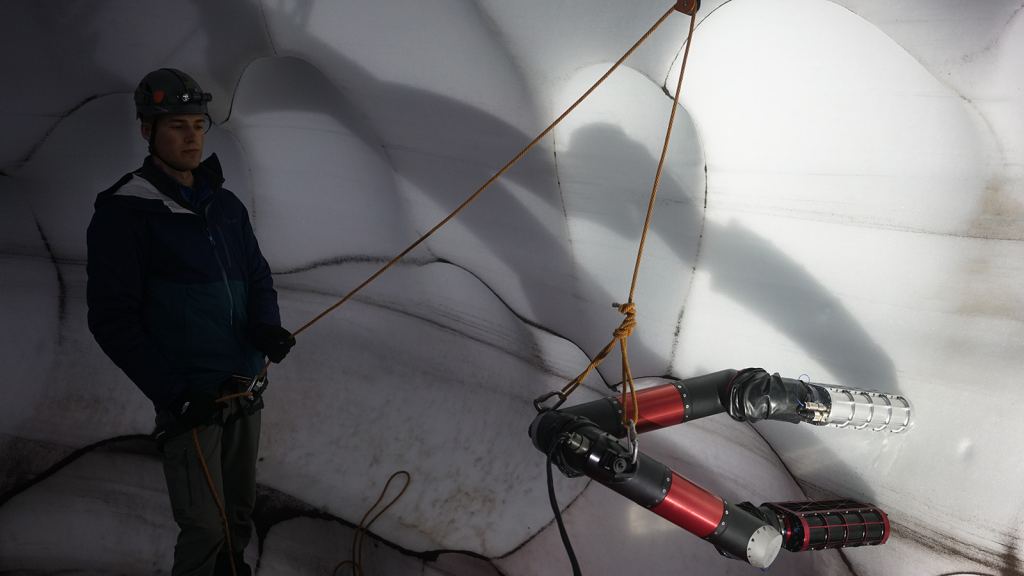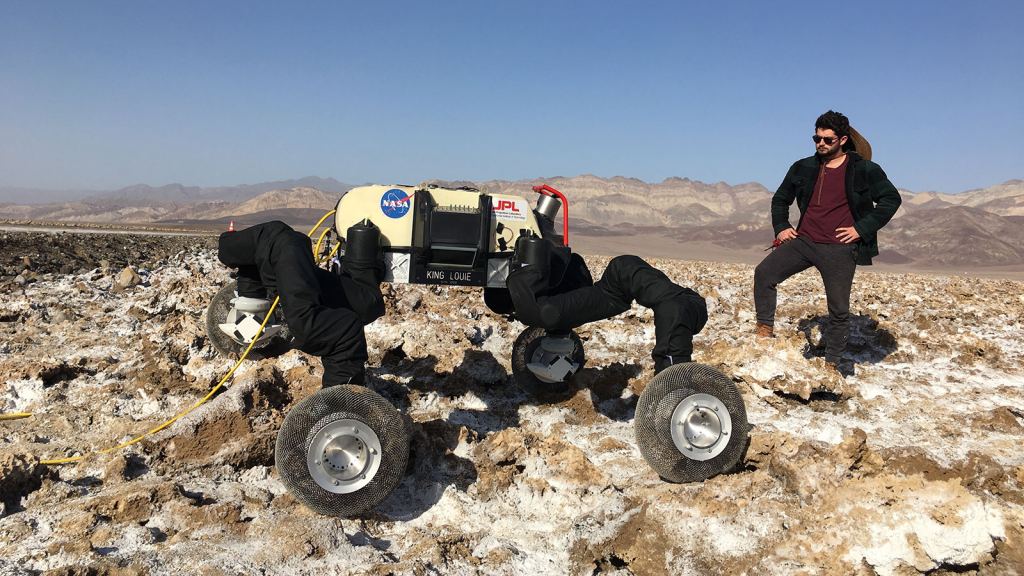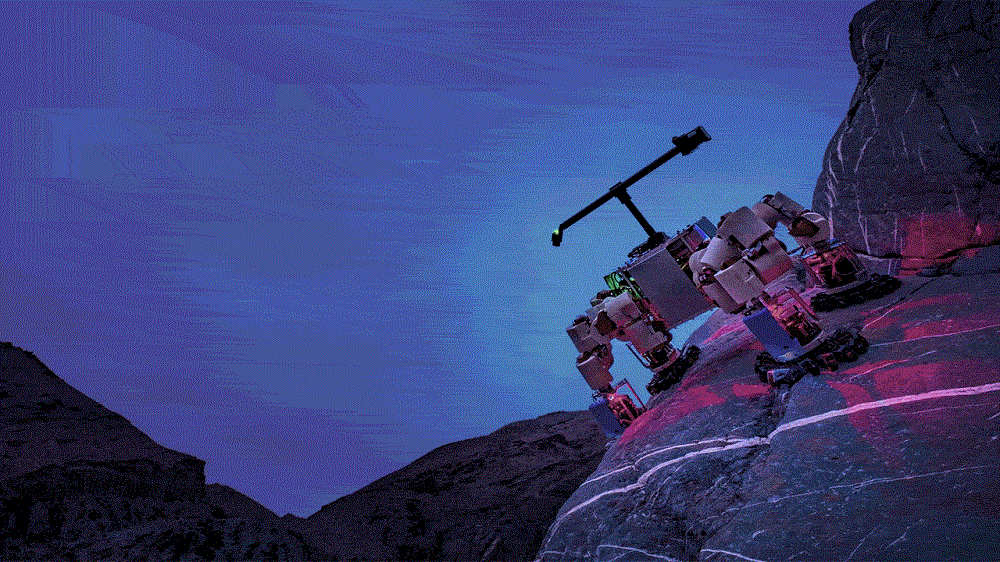NASA has pioneered the development of all kinds of robots and robotic systems. Beyond its0 orbiters and satellites, which have been exploring the planets and bodies of the Solar System for decades, there’s also the growing army of landers and rovers that have been exploring planetary surfaces. Aboard the ISS, they even have floating robots (like CIMON) and humanoid robot helpers – a la Robonaut and Robonaut 2.
Looking to the future, NASA hopes to build robots that can do even more. While the current generation of rovers can drive across the plains and craters of Mars, what if they could explore cliffs, polar ice caps and other hard-to-reach places? That is the purpose behind the Limbed Excursion Mechanical Utility Robot (LEMUR) that is currently being developed by engineers at NASA’s Jet Propulsion Laboratory.
The LEMUR is NASA’s attempt to build a rover capable of climbing up cliffs and scaling along walls. This is done through the use of its four limbs, each of which has 16 fingers with hundreds of tiny fishhooks, and artificial intelligence to find its way around obstacles. Its latest field test took place in early 2019 in Death Valley, California, a region that used to be filled by a sea.
While following a route that led up a cliff, the robot used its suite of scientific instruments to scan the rock for ancient fossils. The ability to look for biosignatures while scaling sloping surface would come in very handy on planet’s like Mars, where sedimentary deposits in ancient lakes beds could hold evidence of past life. This is currently what the Curiosity rover is doing on Mount Sharp in the Mars’ Gale Crater.
Originally, LEMUR was conceived as a repair robot for the International Space Station, a project which has since concluded. Nevertheless, the program led to the development of a new generation of walking, climbing and crawling robots that could prove extremely useful when it comes time to send robotic explorers to Mars or the many icy moons of the Solar System to aid in the search for life.
Those robots are being developed now, honing technology that may one day be part of future missions to distant worlds.
Icy-World Explorer
For this kind of research, JPL is developing the Ice Worm, a robotic explorer that is being developed to navigate slippery, icy surfaces. Adapted from a single limb of LEMUR, Ice Worm slowly scales icy surfaces in much the same way an inchworm moves – by scrunching and extending its limbs.

The robot stabilizes itself as it climbs by drilling one end of a limb into the surface its scaling and can use this same technique to stabilize itself while taking scientific samples. The robot also navigates using LEMUR’s AI, a machine-learning program that learns to select optimal routes by learning from past mistakes.
To develop the robot’s capabilities, JPL project
In the future, robots of this kind are likely to be sent to the icy moons of Saturn and Jupiter to investigate their interior oceans and look for signs of life.
RoboSimian
This concept was originally built as part of the DARPA Robotics Challenge (DRC), which ran from 2012 to 2015 and aimed at the creation of disaster-relief robots. Nicknamed “King Louie” after the character is “The Jungle Book”, RoboSimian takes its name from the fact that it has four legs and is very versatile – it can walk, crawl, inchworm, or slide on its belly.

Since it was first developed, the design has been modified to optimize its mobility in icy environments, particularly the icy, uneven terrain on Saturn’s moon Enceladus. While it uses the same four robotic limbs as LEMUR, JPL engineers replaced the gripping feet with springy wheels made from music wire.
These allow for greater flexibility over uneven terrain, which is essential on a body like Enceladus. Equipped with an advanced suite of spectroscopic instruments, this robot could explore the southern polar region of Enceladus and scan its plumes for signs of organic molecules and biosignatures.
Micro-Climbers
This refers to a class of wheeled vehicles that are small enough to fit in a tight space but are strong enough to scale walls and survive falls from up to 3 meters (9 feet). Originally developed by JPL for the military, some micro-climbers are being repurposed for space exploration. Whereas some use LEMUR’s fishhook grippers to cling to rough surfaces, others can scale smooth surfaces, using gecko adhesive.
Much like the lizard’s feet that inspired it, this technology relies on microscopic angled hairs that generate van der Waals forces – electrostatic attractive forces that occur when surfaces are in close proximity. The robot’s hybrid wheels use an electrical charge to enhance this effect and cling to many kinds of surfaces – including smooth metal walls.

For this reason, micro-climbers with this same adhesive or gripping technology could repair future spacecraft in addition to exploring hard-to-reach spots on the Moon, Mars and beyond.
Ocean to Asteroid Grippers
Taking a page from astronaut training, where underwater exercises simulate what it is like to work in zero gravity, technology built for ocean exploration can be a good prototype for missions to microgravity-environments. This is where the Underwater Gripper comes into play, which uses one of the gripping hands from LEMUR with the same 16 fingers and 250 fishhooks for grasping irregular surfaces.
With some modifications, this robot could be deployed to Near-Earth Asteroids (NEAs) or other small bodies in the Solar System. The purposes of these missions could be anything from sample collection (to learn more about the formation and evolution of the Solar System) to prospecting for minerals and resources.
For the time being, the Underwater Gripper is attached to the Nautilus – an underwater research vessel operated by the Ocean Exploration Trust (OET) off the coast of Hawaii. There, it helps in the advancement of ocean research by taking deep ocean samples from more than 1.6 km (1 mile) below the surface.
Climbing Helicopters
Already, NASA is planning on sending a small, solar-powered helicopter with the Mars 2020 rover to Mars next year. Once the rover lands, this technology demonstrator will fly in short bursts to determine if the concept is an effective means of exploring the Red Planet in the future. Looking to build on that, JPL engineer Arash Kalantari is developing a concept for a gripper that could allow a flying robot to cling to Martian cliffsides.
This mechanism, which would allow the flier to perch, uses the same combination of clawed feet and embedded fishhooks as LEMUR to grip rock much like a bird clings to a branch. While there, the robot would be able to recharge its batteries via solar panels as it searches for evidence of life, allowing for a degree of freedom a flier might not otherwise have.
When looking to the future of space, it is abundantly clear that a growing portion of the exploratory and research work will be handled by robots. Many of these robots will be autonomous in nature and won’t have to rely on human controllers to navigate or control their instruments. This will allow for greater flexibility and the ability to explore regions human explorers typically can’t go.
However, it is also clear that there is no substitute for “boots on the ground”. So if anyone is worried that robots will be usurping all the tasks traditionally performed by astronauts, they can rest easy. In the end, it’s all about enhancing human space exploration, not replacing the humans that bravely do it.
Further Reading: NASA

